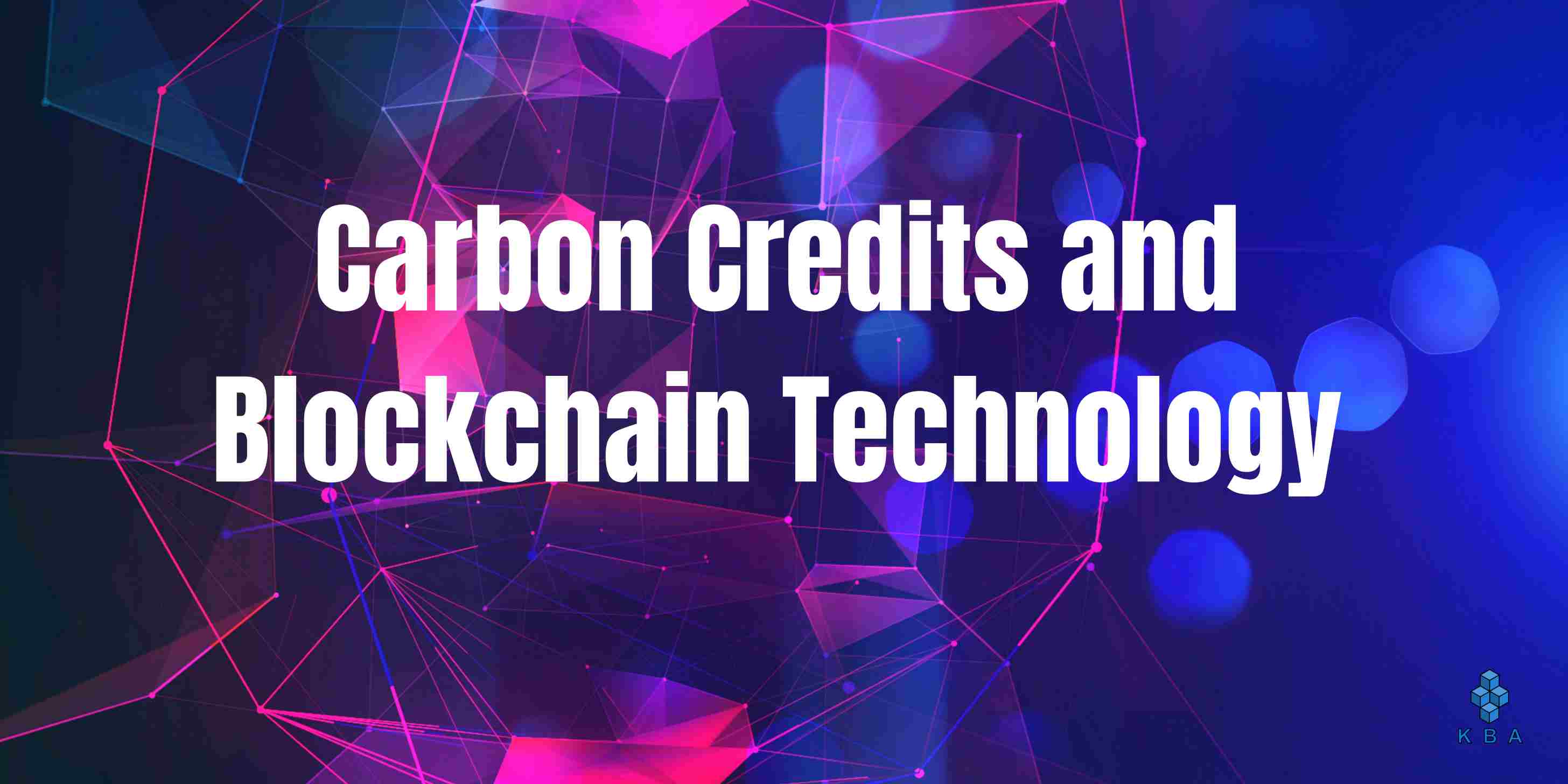The unsustainable development and excessive pollution in the atmosphere lead to climate change and natural disasters. Day by day, news on flash floods, droughts, cloudbursts and extreme weather conditions are flashing in the news. United Nations identifies humans as a causal factor behind climate change that occurred in the past two centuries.
To address the issue of climate change, the international organisations introduced several measures. The introduction of carbon credits to reduce carbon emissions is one such eco-friendly approach. Blockchain carbon credits limit emissions from the environment with digital tokens or cryptocurrencies. Curious to know about carbon credits and blockchain technology?
Carbon Credits- An introduction
Considering the existential crisis, climate change is considered a threat, especially uncontrolled carbon emissions. Carbon credit is framed as a solution to reduce greenhouse gas emissions. The carbon credit system gives monetary or token value for not polluting the environment. In the carbon credit system, an individual, organisation or nation is promised to reduce carbon emissions. If the target emission increases or is above the promised rate, then the concerned party has to balance it. So, a carbon credit is brought from those who have low carbon emissions. Where did it get started?
Origin of Carbon credit
The introduction of carbon credit is credited to the Kyoto Protocol Summit 1997. It advocated the need for a carbon credit, which 150 nations signed the agreement. Through this, countries sell the excess credit to countries that fail to achieve the target. This paved the way for the carbon market, wherein carbon credits are exchanged at a price. The protocol further empowered nations in 2005 by making them aware of the necessity and ways of reducing emissions.
Carbon footprint is the total amount of greenhouse gases produced by our actions. So, it is the responsibility of every individual, enterprise, organisation, and nation to strive towards reducing the carbon footprint. Carbon Credits can be explained as fixing a limit for carbon emissions, which is gradually reduced upon agreement. How can the carbon credits be achieved? Do laws or agreements limit carbon emissions? Such questions paved the way for identifying two strategies to reduce carbon emissions: Compliance and Voluntary carbon emission methods.
Strategical Categorisation of Carbon Credits
This trendsetting protocol envisages implementing a carbon tax by setting up a carbon market to reduce emissions. Such allowances are called Compliance Emission Reduction (CEC) credit. The regional, national or international agencies regulate such carbon markets. It is an imposed form of reduction to attain the ecological goal.
As a counterpart to Compliance Emission, a voluntary initiative was introduced as an ecological responsibility with Voluntary Emission Reduction (VER) credit. In this, every individual, organisation or nation considers limiting carbon emissions a voluntary action.
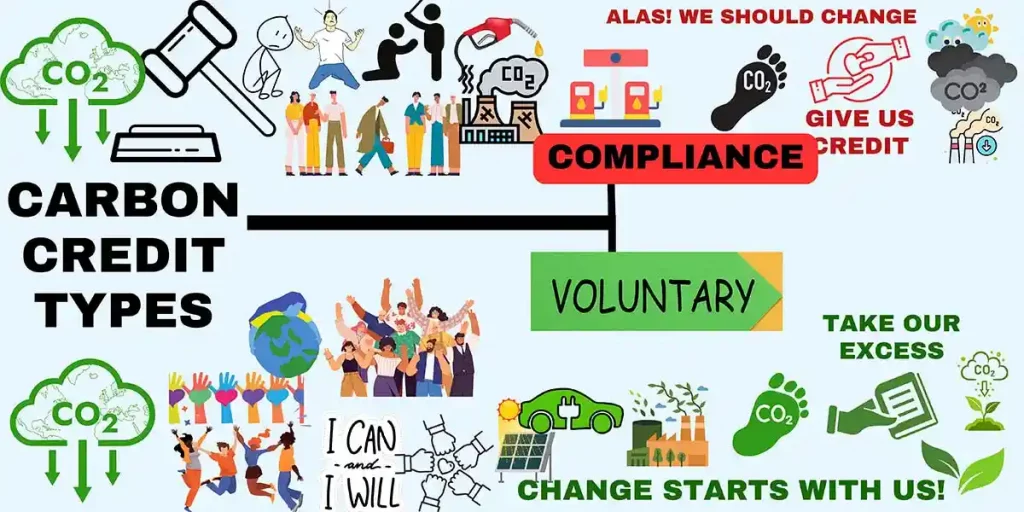
In the compliance model, a central authority gives guidance to reduce carbon emissions. However, this involuntary imposition of norms is sometimes viewed as a burden. Some nations or organisations identify it as a threat to its development plan and economic growth. In the voluntary type, the individual targets are based on personal capacity and willingness towards environmental sustainability. Let’s see the carbon credit exchange system.
How and where the carbon credits are sold?
When an enterprise reduces carbon emissions, it will receive the credit. Such credits can be sold to other enterprises that fail to reduce the rate of carbon emission. Carbon credits are sold and bought in the carbon markets. Some organisations or enterprises reduce and compensate for carbon emissions. The companies or nations can compensate for the greenhouse gas emissions by purchasing carbon credits from such enterprises. This answered the question ‘where’.
But the question ‘how’ resurfaces, and it needs to be discussed from the traditional and digital perspective.
Traditional Mechanism:
In the traditional carbon credit market, the excess carbon is sold for money or material. This method was implemented to assess the price or value of carbon. If a company emits less than the targetted quantity, it will receive the payment from the company that failed in the promise. However, some shortcomings failed the ideology behind this system. For instance, it affects the entities that take offset projects. The credit will be circulated until the ‘end buyer’ retires it from the market. However, the traditional system is centralised and not transparent. So, it failed to reduce carbon from the air.
Take XM Industrial Estate as a fictional example. XM is supposed to reduce carbon emissions, but with its policies, it failed to achieve the target, and the rate increased. In the traditional carbon market, the enterprise received the credit by manipulating the data.
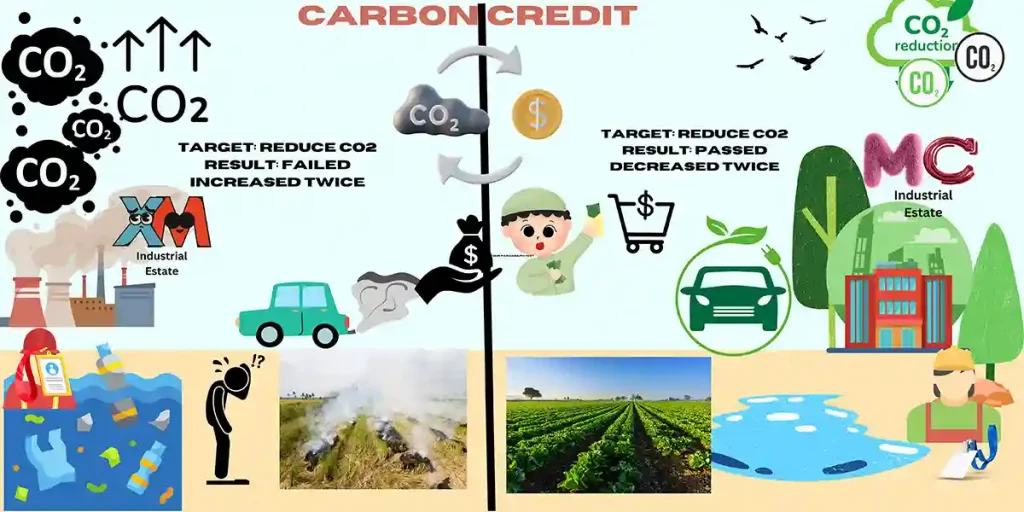
This mechanism failed to achieve the target behind the formation of this system. Such a drawback paved the way for digital mechanisms like blockchain.
Blockchain/ Digital Mechanism:
The strategic failure of the traditional method paved the way for the digital tokenisation of carbon credit. Tokenisation is the representation of assets as a digital or virtual ledger. Selected companies that expect carbon neutrality approach the suppliers. The suppliers sell carbon credit like a Non-Fungible Token (NFT). It eliminates further carbon credit trade.
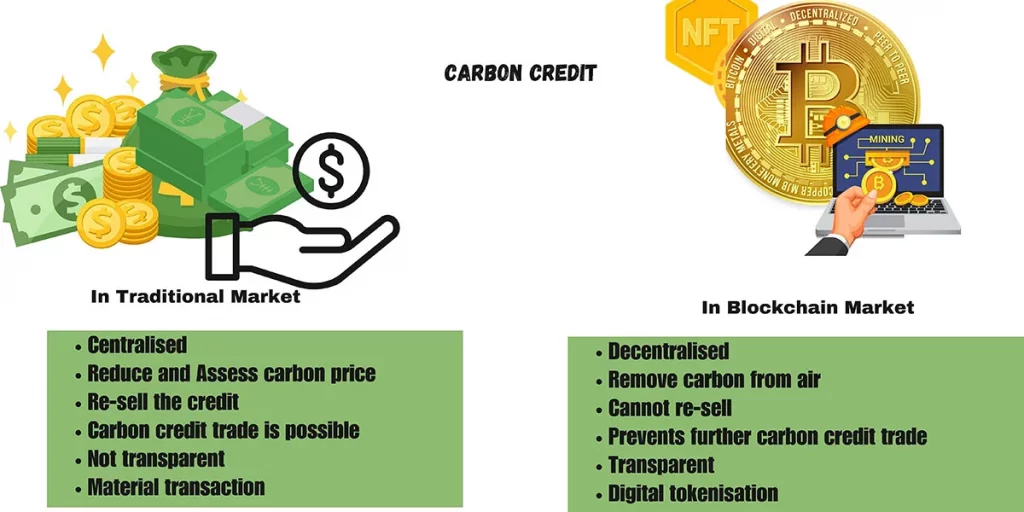
To increase transparency and to ensure decentralisation, the world searched for an alternative blockchain technology entered as a game changer. With the invention of blockchain technology, the need for a digital token is fulfilled. Blockchains use cryptos as a token. So, cryptocurrency is exchanged for carbon credits. Blockchain and crypto-carbon exchange systems mark the future of the carbon credit market!
Blockchain Technology in Carbon Credit
Blockchain is a decentralised, peer-to-peer, distributed ledger technology. The data is securely stored as blocks and is timestamped. Blockchain technology offers unaltered and real-time data. Nori is one of the blockchain carbon removal marketplaces. Algorand, through the smart contract, agreed to remain carbon-negative on a net basis. Unlike the insecurities and non-transparent nature of the centralised, traditional system, blockchains guarantee wide participation. Blockchains verify and track the authenticity of carbon credits. Following are some of the Carbon Credit marketplaces:
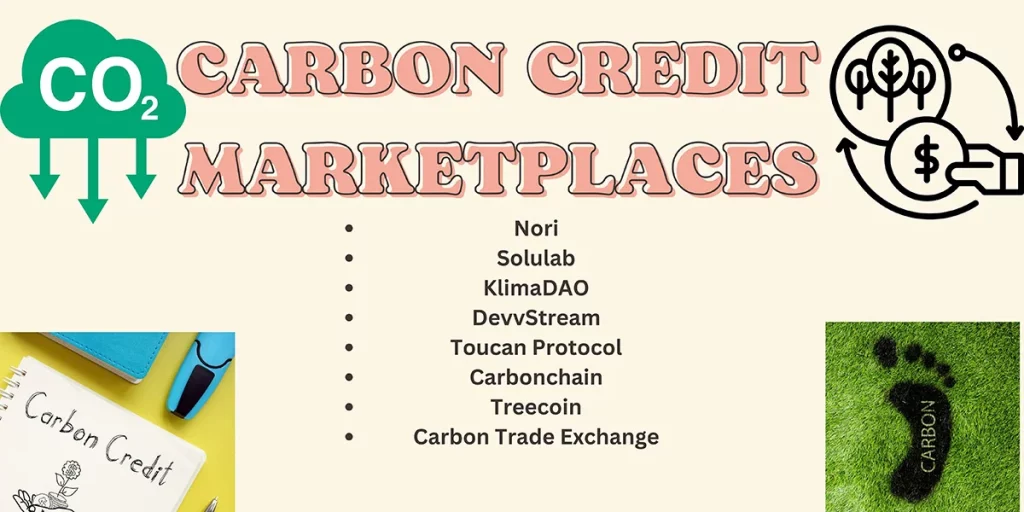
Blockchains are programmed with Smart Contracts and can be tokenised. Blockchain terminates intermediaries and is visible in the blockchain ledger. It removes double claiming of carbon credits. It means data manipulation by portraying sustainable claims for carbon credit is eliminated. How is blockchain helpful? Let us understand it with a sample.
Working Model of Blockchain:
Let us consider the MC Industrial Estate as a counterpart of XM. Here, MC reduced the carbon level as promised. It even reduced twice its targetted rate.
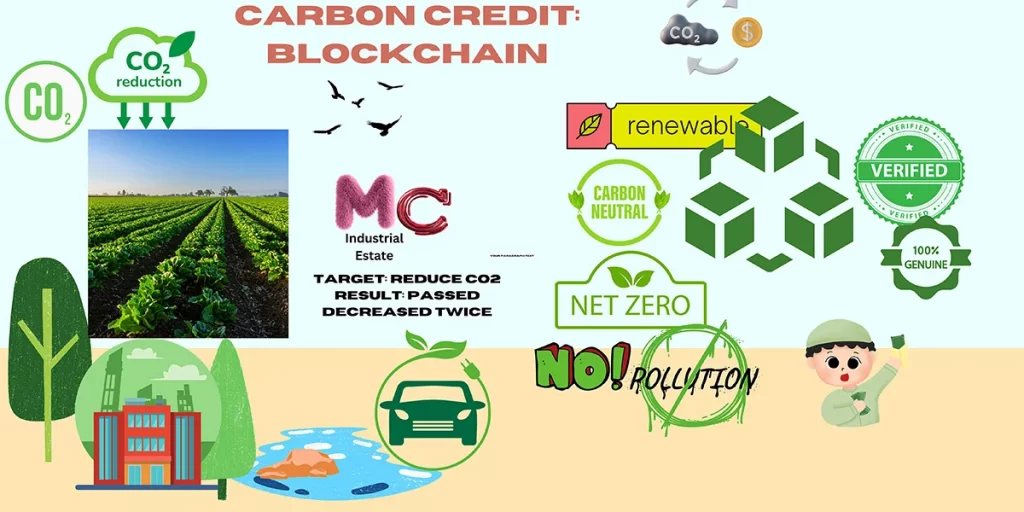
Blockchain adds information with timestamps, so the data cannot be manipulated. The decentralised and distributed ledger technology stores information as blocks. These blocks are shared among all participants in the blockchain network. Since the blocks are digitally signed using a private key, the transactions or data are unalterable. If MC tries to fabricate the information like XM, the blockchain network will repel the manipulated data.
In our example, the blockchain network verified the reduction of carbon emissions of MC Industrial estate. So, without any further procedure, depending on the consensus or agreement, it automatically releases the tokens to MC Industrial Estate.
Traditional Vs. Blockchain Carbon Credit
How different are traditional-centralised carbon credits and decentralised carbon credit blockchains? The following image represents how the carbon credit works based on two fictional industrial estates: XM and MC, respectively. Both industrial estates emit the same quantity of carbon and are pledged to reduce it to a specific level. While validated through blockchain technology, XM Industrial Estate failed to achieve its target and doubled the emission rate. MC Industrial Estate, on the contrary, achieved the target and decreased it twice. So, as per the fact, XM Industrial Estate exchanged the token from MC Industrial Estate for carbon credit.

The decentralised and transparent blockchain technology allowed MC Industrial Estate to receive the token by exchanging the excess credit. Here, MC Industrial Estate reduced carbon emissions by using renewable energy and eco-friendly resources. It also focuses on afforestation and the reduction of pollution rate. XM Industrial Estate burned agricultural waste and emitted carbon from different sources. Using petroleum vehicles and non-eco-friendly factory emissions contributed to its increased carbon rate. Certain types of blockchains (Proof-of-Work) can be mined, which require high power consumption, which is a curse to the eco-friendly approach. Proof-of-Stake, unlike the Proof-of-Work mechanism, is efficient in this approach. Learn more about the best blockchain courses now!
Blockchain and Carbon Trade: A Global Lookup
Every nation is looking for a sustainable solution without intermediaries. Blockchain is one such reliable carbon trading platform. The Venom Foundation partnered with the United Arab Emirates to develop and implement the National Carbon Credit System using blockchain technology. International Finance Corporation, a division of the World Bank, launched a project to use blockchain for carbon removal and to turn carbon credit into cryptocurrencies.
Future of Carbon Credit in India
The future of carbon credits in blockchain technology is favourable. The Government of India pledged to a net-zero carbon emission sustainability commitment. By creating new policies and targets, the Ministry of Environment, Forests, and Climate Change intends to achieve the target by 2070. The government introduced Carbon Credit Trading Scheme, 2023 (CCTS), forming the Indian carbon market by capping and trading the carbon credits. The government expects the industries to limit their carbon emissions as well. To reduce the emission and carbon footprint, a transparent, decentralised ledger system like blockchain technology can be advocated.
CCTS, 2023 envisaged reducing the carbon level by carbon credit trades. The government also introduced the Draft Green Credits Programme Implementation Rules, 2023 towards the goal of a sustainable eco-system. This programme focuses on planting trees, water conservation, sustainable agriculture, waste management, air pollution reduction, mangrove conservation, ecomark labelling, and sustainable constructions. It will aid in balancing the ecological sustainability.
When such new schemes, amendments and policies are introduced, the government and organisations prefer an automated system. Blockchain technology is automated with a consensus mechanism. When such policies are made, the system will automatically identify the criteria based on the Smart Contract.
Conclusion
A carbon credit is the call for ecological sustainability. Reduction of carbon level from the environment is the responsibility of each one of us. To increase the competitive spirit in reducing the carbon footprint, a carbon credit system through carbon markets was introduced. By converting the excess credit for cryptocurrencies or tokens, individuals, nations and organisations can get extra profit. In the digital era, digital tokens or cryptocurrencies are preferred over material tokens.
When carbon reduction is imposed by an external agency in the blockchain system, it burdens the entities. The popularisation of the voluntary carbon reduction model over the compliance model aids in reducing carbon emissions to a great extent. The energy-friendly blockchain networks are efficient in energy conservation. The blockchain carbon credit networks provide the best platform for ecological sustainability and carbon reduction.

